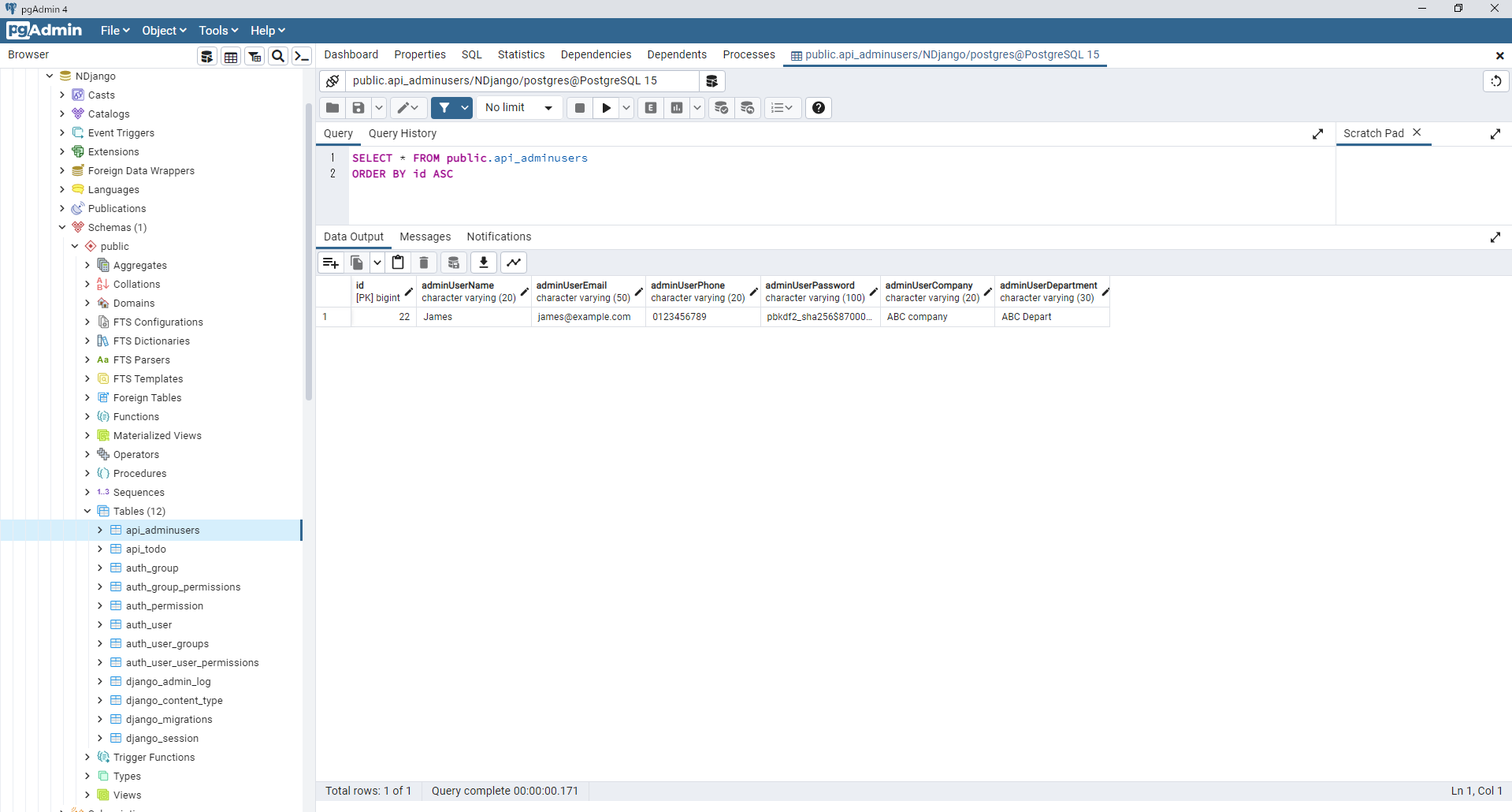サンプル
管理者画面から登録に必要な情報を入力して登録ボタンをクリックします。

フロント側(Next.js)の実装
fronend/app/adminUsers/registration/page.tsx
'use client'
import { useState,useEffect } from "react"
import { useRouter } from "next/navigation"
import axios from "axios"
import { useForm } from "react-hook-form"
export default function AdminUserRegistration(){
const router = useRouter();
const defaultValues = {
adminUserName:'',
adminUserEmail:'',
adminUserPhone:'',
adminUserPassword:'',
adminUserCompany:'',
adminUserDepartment:''
};
const {register,handleSubmit,formState:{errors}} = useForm({
defaultValues
});
const [adminUserName,setAdminUserName] = useState('');
const [adminUserEmail,setAdminUserEmail] = useState('');
const [adminUserPhone,setAdminUserPhone] = useState('');
const [adminUserPassword,setAdminUserPassword] = useState('');
const [adminUserCompany,setAdminUserCompany] = useState('');
const [adminUserDepartment,setAdminUserDepartment] = useState('');
const onSubmit = async (data: any) => {
const formData = new FormData();
formData.append('adminUserName',adminUserName);
formData.append('adminUserEmail',adminUserEmail);
formData.append('adminUserPhone',adminUserPhone);
formData.append('adminUserPassword',adminUserPassword);
formData.append('adminUserCompany',adminUserCompany);
formData.append('adminUserDepartment',adminUserDepartment);
try {
// 正常なレスポンスを処理
const response = await axios.post('http://127.0.0.1:8000/api/adminusers/', formData);
if (response.status === 201) {
alert('管理者を登録できたぜ');
console.log('編きゃされたレスポンスは、',response);
router.push('/');
} else {
console.log('Unexpected status code:', response.status);
}
} catch (error) {
// エラーを処理
console.error(error);
alert('Error occurred while registering the admin user');
}
};
return (
<form onSubmit={handleSubmit(onSubmit)}>
<div>
<label>Name</label>
<input
type="text"
className="w-full border border-gray-500 rounded-md"
defaultValue={defaultValues.adminUserName}
{...register('adminUserName',{
required:'AdminUserNamwe must be required.'
})}
onChange={(e)=>setAdminUserName(e.target.value)}
/>
<div className="text-rose-500">{errors.adminUserName?.message}</div>
</div>
<div>
<label>Email</label>
<input
type="email"
className="w-full border border-gray-500 rounded-md"
defaultValue={defaultValues.adminUserEmail}
{...register('adminUserEmail',{
required:'AdminuserEmail must be required.'
})}
onChange={(e)=>setAdminUserEmail(e.target.value)}
/>
<div className="text-rose-500">{errors.adminUserEmail?.message}</div>
</div>
<div>
<label>Phone</label>
<input
type="text"
className="w-full border border-gray-500 rounded-md"
defaultValue={defaultValues.adminUserPhone}
{...register('adminUserPhone',{
required:'AdminUserPhone must be required.'
})}
onChange={(e)=>{setAdminUserPhone(e.target.value)}}
/>
<div className="text-rose-500">{errors.adminUserPhone?.message}</div>
</div>
<div>
<label>Password</label>
<input
type="password"
className="w-full border border-gray-500 rounded-md"
defaultValue={defaultValues.adminUserPassword}
{...register('adminUserPassword',{
required:'AdminUserPassword must be required.'
})}
onChange={(e)=>setAdminUserPassword(e.target.value)}
/>
<div className="text-rose-500">{errors.adminUserPassword ?.message}</div>
</div>
<label>Company</label>
<input
type="text"
className="w-full border border-gray-500 rounded-md"
defaultValue={defaultValues.adminUserCompany}
{...register('adminUserCompany',{
required:'Company must be required.'
})}
onChange={(e)=>setAdminUserCompany(e.target.value)}
/>
<div className="text-rose-500">{errors.adminUserCompany?.message}</div>
<div>
<label>Department</label>
<input
type="text"
className="w-full border border-gray-500 rounded-md"
defaultValue={defaultValues.adminUserDepartment}
{...register('adminUserDepartment',{
required:'Departmanet muset be required.'
})}
onChange={(e)=>{setAdminUserDepartment(e.target.value)}}
/>
<div className="text-rose-500">{errors.adminUserDepartment?.message}</div>
</div>
<div>
<button
type="submit"
className="bg bg-blue-500 text-white rounded-md px-4 py-4"
>
Register
</button>
<button
type="button"
className="bg bg-green-500 text-white rounded-md px-4 py-4"
>
Back to Top
</button>
</div>
</form>
)
}
バックエンド側(Django)の実装
データベース周りの設定
backend/todoList/setting.py
"""
Django settings for todoproject project.
Generated by 'django-admin startproject' using Django 5.1.7.
For more information on this file, see
https://docs.djangoproject.com/en/5.1/topics/settings/
For the full list of settings and their values, see
https://docs.djangoproject.com/en/5.1/ref/settings/
"""
import os # 追加
from pathlib import Path
# Build paths inside the project like this: BASE_DIR / 'subdir'.
BASE_DIR = Path(__file__).resolve().parent.parent
# Quick-start development settings - unsuitable for production
# See https://docs.djangoproject.com/en/5.1/howto/deployment/checklist/
# SECURITY WARNING: keep the secret key used in production secret!
SECRET_KEY = 'django-insecure-6@l&+js7s77)@o_tifmlf+^gvv*_&i(4m@2hal#7x+8nczn23h'
# SECURITY WARNING: don't run with debug turned on in production!
DEBUG = True
ALLOWED_HOSTS = []
# Application definition
INSTALLED_APPS = [
'django.contrib.admin',
'django.contrib.auth',
'django.contrib.contenttypes',
'django.contrib.sessions',
'django.contrib.messages',
'django.contrib.staticfiles',
'rest_framework',#追加
'api',#追加
'corsheaders',#追加
]
MIDDLEWARE = [
'django.middleware.security.SecurityMiddleware',
'django.contrib.sessions.middleware.SessionMiddleware',
'django.middleware.common.CommonMiddleware',
'django.middleware.csrf.CsrfViewMiddleware',
'django.contrib.auth.middleware.AuthenticationMiddleware',
'django.contrib.messages.middleware.MessageMiddleware',
'django.middleware.clickjacking.XFrameOptionsMiddleware',
'corsheaders.middleware.CorsMiddleware',#追加
]
ROOT_URLCONF = 'todoproject.urls'
TEMPLATES = [
{
'BACKEND': 'django.template.backends.django.DjangoTemplates',
'DIRS': [],
'APP_DIRS': True,
'OPTIONS': {
'context_processors': [
'django.template.context_processors.debug',
'django.template.context_processors.request',
'django.contrib.auth.context_processors.auth',
'django.contrib.messages.context_processors.messages',
],
},
},
]
WSGI_APPLICATION = 'todoproject.wsgi.application'
# Database
# https://docs.djangoproject.com/en/5.1/ref/settings/#databases
DATABASES = {
'default': {
'ENGINE': 'django.db.backends.postgresql',
'NAME': 'NDjango',
'USER':'postgres',
'PASSWORD':'XXXXXX',
'HOST':'localhost',
'PORT':'5432',
}
}
# Password validation
# https://docs.djangoproject.com/en/5.1/ref/settings/#auth-password-validators
AUTH_PASSWORD_VALIDATORS = [
{
'NAME': 'django.contrib.auth.password_validation.UserAttributeSimilarityValidator',
},
{
'NAME': 'django.contrib.auth.password_validation.MinimumLengthValidator',
},
{
'NAME': 'django.contrib.auth.password_validation.CommonPasswordValidator',
},
{
'NAME': 'django.contrib.auth.password_validation.NumericPasswordValidator',
},
]
CORS_ALLOWED_ORIGINS = [#追加
'http://localhost:3000',
]
# Internationalization
# https://docs.djangoproject.com/en/5.1/topics/i18n/
LANGUAGE_CODE = 'en-us'
TIME_ZONE = 'UTC'
USE_I18N = True
USE_TZ = True
# Static files (CSS, JavaScript, Images)
# https://docs.djangoproject.com/en/5.1/howto/static-files/
STATIC_URL = 'static/'
# Default primary key field type
# https://docs.djangoproject.com/en/5.1/ref/settings/#default-auto-field
DEFAULT_AUTO_FIELD = 'django.db.models.BigAutoField'
MEDIA_URL = '/media/'#追加
MEDIA_ROOT = os.path.join(BASE_DIR, 'media')#追加
Modelsクラスの実装
backend/api/models.py
from django.db import models
# Create your models here.
class Todo(models.Model):
title = models.CharField(max_length=100)
completed = models.BooleanField(default=False)
attachment = models.FileField(upload_to='uploads/', blank=True, null=True) # Optional file attachment
def __str__(self):
return self.title
class AdminUsers(models.Model):
adminUserName = models.CharField(max_length=20,blank=False,null=False)
adminUserEmail = models.CharField(max_length=50,blank=False,null=False)
adminUserPhone = models.CharField(max_length=20,blank=False,null=False)
adminUserPassword = models.CharField(max_length=100,blank=False,null=False)
adminUserCompany = models.CharField(max_length=20,blank=False,null=False)
adminUserDepartment = models.CharField(max_length=30,blank=False,null=False)
def __str__(self):
return self.adminUserName
Serializerクラスの実装
パスワードハッシュ化の実装について
パスワードをハッシュ化するcreate関数は、class Metaクラスと同じ階層に配置します。
階層の配置を間違えると、処理が正しく動作しないので注意してください。
backend/api/serializer.py
class AdminUsersSerializer(serializers.ModelSerializer):
class Meta:
model = AdminUsers
fields = ['id','adminUserName','adminUserEmail','adminUserPhone','adminUserPassword','adminUserCompany','adminUserDepartment']
adminUserPassword = serializers.CharField(write_only=True)
extra_kwargs = {
'adminUserPassword':{'write_only':True}
}
def create(self, validated_data):
# パスワードをハッシュ化
password = validated_data['adminUserPassword']
hashed_password = make_password(password)
validated_data['adminUserPassword'] = hashed_password
# 新しいユーザーを作成
return super().create(validated_data)
backend/api/serializer.py
from rest_framework import serializers
from .models import Todo,AdminUsers
from django.contrib.auth.hashers import make_password
class TodoSerializer(serializers.ModelSerializer):
class Meta:
model = Todo
fields = ['id', 'title', 'completed', 'attachment'] # Include necessary fields
class AdminUsersSerializer(serializers.ModelSerializer):
class Meta:
model = AdminUsers
fields = ['id','adminUserName','adminUserEmail','adminUserPhone','adminUserPassword','adminUserCompany','adminUserDepartment']
adminUserPassword = serializers.CharField(write_only=True)
extra_kwargs = {
'adminUserPassword':{'write_only':True}
}
def create(self, validated_data):
# パスワードをハッシュ化
password = validated_data['adminUserPassword']
hashed_password = make_password(password)
validated_data['adminUserPassword'] = hashed_password
# 新しいユーザーを作成
return super().create(validated_data)
views.pyの実装
backend/api/views.py
#from django.shortcuts import render
from rest_framework.decorators import api_view #追加
from rest_framework.response import Response # 追加
from rest_framework import status #追加
from django.db import transaction # 追加
from django.contrib.auth.hashers import make_password #追加
from rest_framework import viewsets
from .models import Todo,AdminUsers
from .serializers import TodoSerializer,AdminUsersSerializer
# Create your views here.
class TodoViewSet(viewsets.ModelViewSet):
queryset = Todo.objects.all()
serializer_class = TodoSerializer
class AdminUsersViewSet(viewsets.ModelViewSet):
queryset = AdminUsers.objects.all()
serializer_class = AdminUsersSerializer
@api_view(['POST'])
def create_admin_user(request):
if request.method == 'POST':
# Start transaction
with transaction.atomic():
serializer = AdminUsersSerializer(data=request.data)
if serializer.is_valid():
#Generate Password Hash
password = serializer.validated_data['adminUserPassword']
hashed_password = make_password(password)
#Set hasedPassword to Data
serializer.validated_data['adminUserPassword'] = hashed_password#hashed_password
if serializer.is_valid():
serializer.save()
return Response(serializer.data,status=status.HTTP_201_CREATED)#serializer.data
else:
return Response(serializer.errors,status=status.HTTP_400_BAD_REQUEST)#serializer.data
